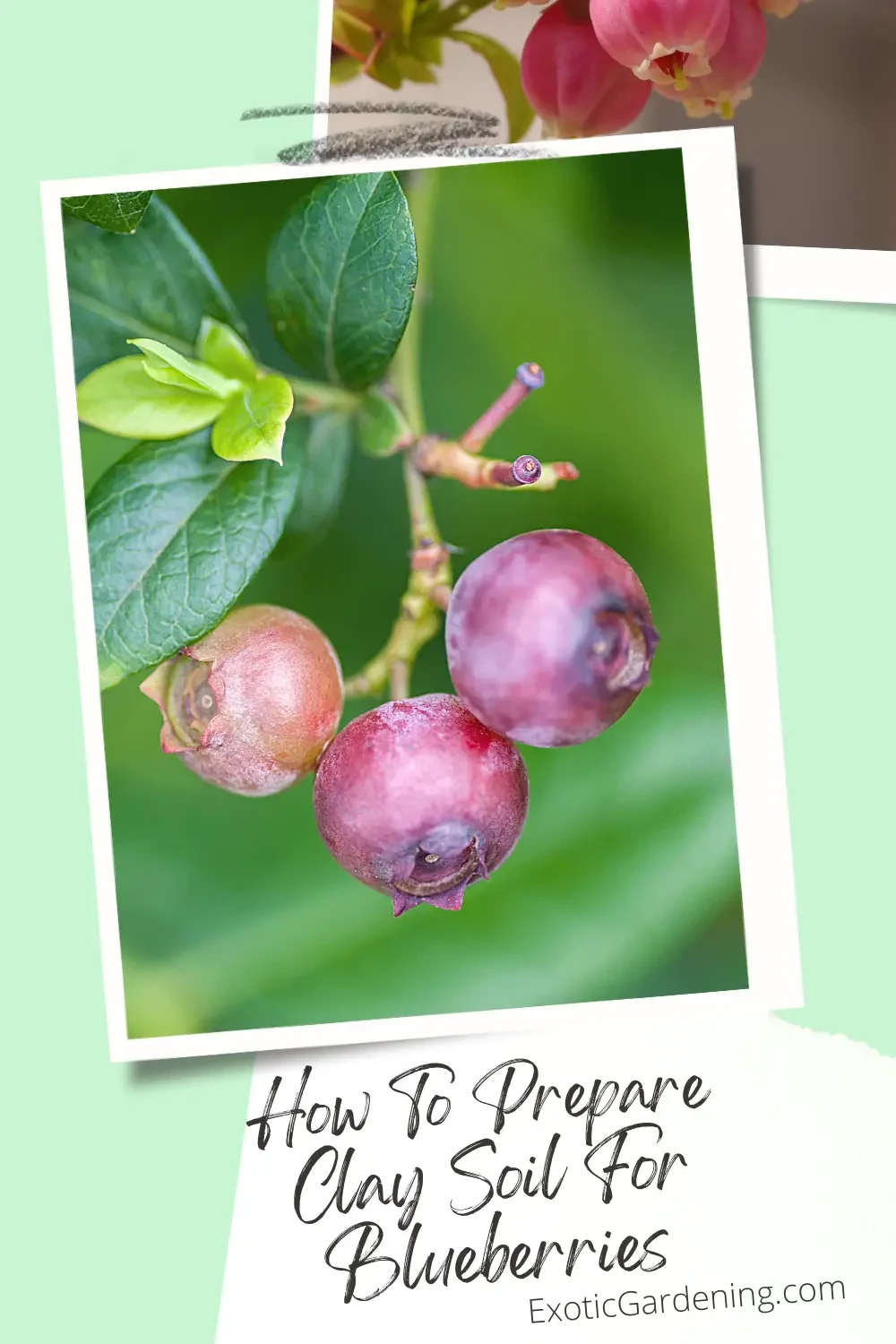Unlocking the secrets to cultivating thriving blueberries starts with the crucial question: how to prepare clay soil for blueberries?
It's a journey that goes beyond simply planting and reaps the sweet rewards of understanding the intricacies of blueberry-friendly environments.
Growing these berries demands a meticulous approach, honing in on their unique soil preferences and environmental needs.
With a distinctive set of requirements, blueberries stand out among fruits, making it essential to delve into the specifics of pH levels, soil composition, and nutrient necessities.
Now, when it comes to clay soil, the journey takes a turn.
Amendments become the key, transforming the soil's structure, enhancing drainage, and, importantly, tweaking its acidity to create a fertile haven for your blueberry bushes.
So, let's dive into the world of clay soil transformation, unlocking the secrets to a bountiful blueberry harvest!
Understanding Blueberry Soil Preferences
Thriving blueberries are a sight to behold, aren’t they?
Their ethereal blue hue, bountiful clusters, and succulent taste are enough to quicken any gardeners' pulse.
The joy of picking these delightful berries right in your backyard is unmatched.
So what’s the secret?
Well, blueberries are not a plant which you can haphazardly toss into the ground and simply hope for the best—they demand more attention and care.
In particular, their soil requirements are a little special on the scale of garden fruit.
Soil pH: Get the Balance Right
The heart of the matter lies in understanding the soil pH.
This is the measure that tells us how acidic or alkaline the soil is.
Blueberries prefer soil on the acidic side, with a pH level ranging from 4.0 to 5.5 — that’s even more acidic than most other garden fruits.
Garden centers often offer soil testing services which reveal your soil’s pH level.
Alternatively, DIY test kits can be purchased online or in garden stores.
Amendments: Make It Right
Should you find your soil's pH falls outside the optimal range, there is no need to worry!
The solution can be as simple as a handful of soil amendments.
To increase acidity, products like elemental sulfur, iron sulfate, or organic matter such as sphagnum peat can be mixed into the soil.
But, be aware that changing the pH of soil is not as easy as it to change the pH of water in a hydroponic unit.
Texture: Let It Loose
Now, let's talk about texture—blueberries, they love going in well-drained, airy soil.
That's where loans and sandy loamy soil step into the spotlight.
Packed with organic goodness, these healthy soil types give those blueberry roots the space to breathe, all while keeping the perfect moisture balance.
It’s vital to be wary of heavy, clay-like soils; because these types of soil inhibit growth, suffocate roots, and lead to waterlogging.
It's a soil texture dance, and blueberries prefer the lighter, more organic type of soil.
Mulch: Keep It Moist
Moving on to another key element, blueberries thrive when mulched.
Mulch not only fends off weeds that rob your plants of nutrients but also keeps the soil nice and moist.
Blueberries have shallow root systems, making them susceptible to drought.
Mulching with materials like pine bark or woodchips helps retain moisture and protect these delicate roots.
Nutrients: Treat Them Right
Finally, keep an eye on nutrient content.
Blueberries primarily require a slow-release, balanced fertilizer containing nitrogen, phosphorus and potassium.
Addition of any fertilizer should be done in moderation, with reference to a soil test; too much can lead to weak growth and poor fruiting.
Growing blueberries can indeed be a thrilling journey, punctuated with bouts of learning and delectable rewards.
Prepare the soil the right way before planting them, and these elusive berries will be ready to burst into a symphony of color and taste right in your own backyard.
Turning Clay into a Blueberry Paradise: A Guide to Amending Soil for Optimal Growth
After understanding the significance of soil pH, the need for balanced fertilizer, and how mulch can protect those precious shallow root systems, it's time now to learn how to amend clay soil.
It is essential to transform that stubborn, compacted clay into a well-aerated and blueberry-friendly patch of earth!
This step requires you to get your hands dirty and begin the transformation from a drab clay garden plot to a vibrant blueberry bed.
The Challenges of Clay:
First, let's consider the properties of clay soil.
It's dense, slow draining, and its fine particles compact easily.
Unfortunately, these characteristics can make clay soil less than ideal for blueberry plants.
The Right Ingredients for Success:
But all is not lost.
Sand, organic matter, and targeted nutrients can come to the rescue.
Introducing these amendments will create an environment conducive to healthy, fruitful blueberry bushes.
- Sand: The addition of course sand will improve soil aerification and drainage. This tops the list of tactics because blueberries need well-drained soil. When worked in, sand puts space between clay particles allowing water and air to infiltrate freely.
- Organic Matter: Amending clay soil with organic materials is a traditional practice that works wonders. Compost, aged manure, and leaf mold are among the best additions. They not only loosen the soil but also improve the microbial activity that facilitates nutrient uptake.
- Nutrient Adjustments: Remember, blueberries need a balanced fertilizer. However, dealing with clay soil often requires extra consideration. A soil test kit can help identify the nutrient levels and guide your choice of amendments. For instance, adding elemental sulfur can lower soil pH, making it more suitable for blueberries, while iron sulfate and aluminum sulfate can fix any iron or aluminum deficiency.
The Amending Process:
- Start by turning over the top 6 to 8 inches of soil. This eases the incorporation of sand and organic materials.
- Add the coarse sand and organic matter. A good ratio is one part sand to two parts compost or leaf mold, adjusted according to the specific texture of your clay soil.
- Blend the new materials into the existing soil, ensuring an even distribution of sand and organic materials throughout.
- Next, use the results from your soil test to guide the addition of supplements. This could involve adding a specific type of mineral or adjusting the amounts of a certain nutrient. The goal is balanced nourishment for your blueberries.
- After amending, allow the soil to rest before planting. A few weeks will give it time to settle and for the organic materials to begin decomposing. Impatient? Consider covering the amended soil with a layer of mulch to speed up the process.
Success won't happen overnight.
However, by continuously amending your soil season after season, you’ll be rewarded with a nutritious, healthy medium suitable for blueberries.
Fueling Growth: Elevating Blueberries with Coffee Grounds
Let's dive into the exciting realm of coffee grounds and their potential to supercharge your blueberry patch.
Blueberries have a thing for acidity, and coffee grounds deliver just that.
They act like a natural acidity enhancer, creating an environment that blueberries absolutely love.
Seamless Integration
Using coffee grounds is a piece of cake.
Simply sprinkle them around the base of your blueberry bushes.
It's a gradual infusion of goodness, providing the soil with nitrogen—a crucial nutrient for those luscious blueberry clusters.
As coffee grounds break down, they contribute to the organic matter in your soil.
This not only enhances soil structure but also improves water retention and aeration, fostering robust root development.
A Pinch of Moderation
A word of caution—moderation is the golden rule.
Too many coffee grounds can swing the pH balance too far.
So, a sprinkle here and there, blended with other organic materials, is the secret to success.
If you do not drink coffee, there is no need to brew it just for your blueberry patch.
Many places, like Starbucks give away their leftover coffee grounds, but you have to be there at the right time because they disappear fast.
Maintaining Optimal Soil Conditions
Let's dive into the art of turning clay soil into a haven for those delectable blueberries.
It might seem like a chore, but trust me, the juicy reward is worth the effort.
Deciphering Clay's Secrets
First off, let's break down the clay soil's composition.
It's a mix of minerals like aluminum and iron—surprisingly good for blueberries.
It also contains silica, magnesia, potassium, sodium and calcium among other things.
Knowing what clay soil is made up of is like having the secret formula for the best nutrient balance.
Conquering Soil Conditioning
Now, onto the challenge of conditioning the soil.
Clay's compact structure can cramp those roots, but here's the scoop: less is more.
Avoid going overboard with cultivation.
Throw in some crop rotation by interplanting the blueberry beds with beans and peas —they're like the superheroes breaking up the soil and keeping it disease-free.
Unearthing Cover Crop Magic
Another option is to use cover crops before you plant your bluberries.
Cover crops are the unsung heroes.
Their roots do the tango with tight clay soil, and when their time is up, they become a gift to the soil.
It's a win-win for a healthy soil vibe.
The Watering Dilemma
Achieving the right mix of well-drained soil and consistent moisture is a bit of an art.
Simply put, think about using drip irrigation to ensure your blueberry roots stay consistently hydrated without any fancy routines and without the soil becoming waterlogged.
Soil Check-ups: The Annual Ritual
Regular soil tests act as health check-ups for your garden.
Make it a yearly or bi-yearly routine to spot any issues that could disrupt your blueberry crops.
Microbial Allies: Nature's Assistants
Meet your soil's MVPs - beneficial microbes, with mycorrhizal fungi taking the lead role.
These invaluable microorganisms are like the MVPs of your garden, working tirelessly beneath the surface to orchestrate a symphony of benefits.
Mycorrhizal fungi, in particular, deserve a standing ovation for their role in forming symbiotic relationships with plant roots.
Picture this: they act as nature's underground delivery service, enhancing nutrient absorption for plants and improving the overall soil structure.
It's a dynamic partnership where the fungi receive sugars from the plants in exchange for essential nutrients like phosphorus and nitrogen.
This nutrient exchange not only nourishes your blueberries but also promotes a healthier, more robust soil environment.
So, as you tend to your garden, remember the microbial MVPs work behind the scenes, but their impact on your soil and blueberry grove is nothing short of extraordinary
In a nutshell, coaxing blueberries to thrive in clay soil is an ongoing process.
Keep the soil loamy, keep it hydrated, and keep it nutrient-packed.
Sustaining Blueberry Bliss: Nurturing Soil Long After Planting
Delving into the intricacies of soil conditions doesn't conclude once the blueberries find their spot.
It's an enduring journey, demanding a watchful eye on soil acidity and a consistent infusion of organic goodness.
This perpetual balance is the key, ensuring the soil consistently caters to the blueberry's needs for optimal growth.
Through this dedicated care, your clay soil transforms into more than just a residence for blueberries—it evolves into a sustainable haven, fostering years of hearty and plentiful growth.
Growing Blueberries FAQ
Q. Can I grow blueberries in containers?
A. Absolutely! Blueberries thrive in containers, provided you use acidic soil, offer proper drainage, and choose a compact variety suitable for container gardening.
Q. How often should I water my blueberry bushes?
A. Blueberries prefer consistently moist soil, especially during dry spells. Aim for about 1 to 2 inches of water per week, either through rainfall or irrigation.
Q. Are there specific pruning techniques for blueberry bushes?
A. Yes, pruning is crucial for blueberry health. Remove dead or diseased wood, and conduct regular thinning to improve airflow and light penetration. Each variety may have slight pruning nuances, so it's good to research your specific type.
Q. When is the best time to fertilize blueberries?
A. Spring is an ideal time for fertilizing blueberries. Use a balanced, acidic fertilizer, and follow the recommended application rates based on the age of your bushes.
Q. Do blueberries need full sun?
A. Yes, blueberries thrive in full sun. Aim for at least 6 to 8 hours of direct sunlight daily for optimal growth and fruit production.
Q. How do I protect my blueberries from birds?
A. Netting is an effective way to protect your blueberries from birds. Ensure the netting is secured properly to prevent any feathered friends from enjoying your harvest.
Q. Can I grow different varieties of blueberries together?
A. Yes, you can plant multiple blueberry varieties in the same area, promoting cross-pollination and potentially enhancing fruit production. However, be mindful of their individual spacing requirements.
Q. What is the best way to test soil acidity for blueberries?
A. Conduct a soil pH test using a reliable kit. Blueberries prefer acidic soil with a pH range between 4.0 and 5.5. Amendments like sulfur can be added to adjust the acidity if needed.
Q. Are blueberries prone to specific pests or diseases?
A. Blueberries may face challenges like aphids, mites, or fungal issues. Regular inspection, proper pruning, and using organic pest control methods can help mitigate these concerns.
Q. How long does it take for blueberry bushes to start producing fruit?
A. Blueberry bushes typically start producing fruit in their second or third year after planting. Patience is key, as the reward of a bountiful harvest awaits in the subsequent years.










